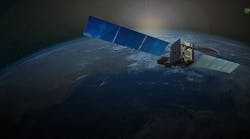The influx of high-throughput-satellite (HTS) capacity and the adoption of satellites using this technology are set to accelerate over the next decade, according to a report from Euroconsult. “High Throughput Satellites: On Course for New Horizons” predicts that HTS systems are expected to grow from 107 GBytes/s in 2014 to just over 1300 GBytes/s in 2023—a CAGR of more than 30% over the said period. HTS capacity supply is projected to nearly triple in the next three years alone, rising from 600 GBytes/s in 2014 to 1720 GBytes/s in 2017.
This growth stems, in part, from the extensive investments made by satellite operators in HTS-capacity supply ranging from Ka-band to more recent Ku-band adoption. Examples of these operators include Telesat, SES, and Eutelsat. In addition, various factors are expected to aid in the expansion of HTS services. While there are currently 2.5 million consumer broadband subscribers, that number is expected to grow to 8.8 million by 2023. The number of commercial satellites is expected to grow from 6 to 22,000 over the same time period. In the next decade, the number of connected mobile 3G satellites will increase from 20 to 6000 while the number of active HTS satellite operators will increase from 14 to 25.
Euroconsult expects North America’s consumer broadband services to remain the largest user of HTS capacity through 2023, comprising 35% of total usage. Together with cellular-backhaul trunking, civil-government and enterprise networks are expected to grow in usage (34% by 2023). This growth will be derived from demand in Latin America, the Middle East and Africa, and the Asia-Pacific region. HTS demand is also expected to accelerate in commercial mobility markets—specifically, aviation and maritime. Whereas military satellite-communications (satcom) usage is expected to remain modest through 2023, HTS demand for video services is expected to gradually grow over the next decade.
